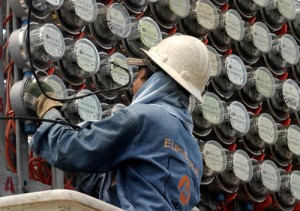The tight and unreliable power supply in Luzon could trigger a spike in electricity rates, Meralco Chairman Manny Pangilinan warned on Monday.
Pangilinan said the rate hikes Meralco imposed late last year that was questioned before the Supreme Court highlighted the
frailties in the electricity supply chain.
“There is a perceived, if not acceptable, narrowing gap between reliable capacity and growing market demand, aging generating plants and increasingly severe climate changes,” he said.
Pangilinan said the “recent two-month spike of the generation charge, while an aberration due to all the factors already thoroughly discussed, remain a key concern that we are addressing.”
He said the power utility is “working even more closely now with all the participants of the supply chain, including government, to mitigate the risks of a similar occurrence in the future, even as the more fundamental solution of new power generating capacity being developed and coming on stream, requires a much longer time frame.”
Meralco president Oscar Reyes said if the Malaya plant in Rizal will not run at full capacity, the power supply in Luzon will be tighter and will lead to “certain risks” which he did not specify.
”Malaya has significant capacity. In fact, Malaya was built in early 70s, late 60s as a base load plant. [If Malaya wouldn’t run] we have to hope that there’ll be no forced outages...that plants will continue to behave. We have ageing plants, which have been disintegrated. We have to hope that there will be no forced outages that can compound scheduled maintenance,” Reyes said.
”The problem is Malaya should run at 610 [MW],” Ricardo Buencamino, Meralco Senior Vice President and Networks Head said.
If it does not run, the price of the power in the country’s electricity spot market may eventually shoot up, he warned.
This summer, several plants will go offline for maintenance. The Ilijan plant of Kepco Philippines Corp., which can produce up to 1,200 megawatts, has already started maintenance shutdown.
The San Lorenzo power plant of First Gas Power Corp., which has a capacity of 500 megawatts, will be out for upgrade from April 9 to May 16.
The cost of traded electricity at the spot electricity market in from October to December rose following the scheduled shutdown of the Malampaya natural gas facility. The situation worsened when other power plants shut down one after the other.
The Supreme Court stopped Meralco from collecting the record P4.15 per kilowatt-hour (kwh) increase granted by the Energy Regulatory Commission (ERC) late last year. There is also a pending P5.33 per kwh hike for January.
In Malacañang, presidential spokesman Edwin Lacierda also warned of power outages but downplayed a report by the Philippine Chamber of Commerce and Industry (PCCI) that the power situation had reached critical levels.
“There is no problem, supply problem with Luzon and Visayas,” Lacierda told reporters.
He admitted that Energy Secretary Jericho Petilla had said brownouts are likely because of the tight supply.
“The supply in Luzon is a bit tight but we can handle the energy concerns,” Lacierda said.
The PCCI earlier warned that the power supply situation in the country is at a critical stage and called for a well-planned domestic strategy to avert the approaching crisis.
The group said the power shortfall arises from the absence of a concrete, well-coordinated national plan on power plant development and private-public efforts to communicate the plan to communities that will be affected by construction projects.
The power problem in Mindanao is expected to ease beginning in 2015, Lacierda said.
“Everything—as stated already by Secretary Petilla even before—it will fully be normalized in 2015, when the power plants owned by Alsons and by Aboitiz will be operational, sometime in 2015,” he said.
He clarified that not all areas in the South are experiencing power problems.
Davao, Cagayan de Oro, Iligan, Bukidnon, Agusan del Norte, and Misamis Oriental have power because they have embedded generators, he said.
“Some cooperatives have power plants. Second, they have embedded generators and they have contracted diesel generators,” Lacierda said.
On Monday, Bayan Muna asked the Supreme Court to cite Meralco in contempt for charging and collecting from consumers the P4.15.
In an omnibus motion, Rep. Neri Colmenares of Bayan Muna urged the Court to order Meralco to show cause why it should not be cited in contempt and to submit a compliance report on its implementation of the TRO.
Colmenares said the firm should reveal how many of its customers paid the rate increase before the tribunal issued a temporary restraining order stopping the rate increase, how many paid as a result of the confusing billing format questioned, how much is the interest gathered from the payments of consumers before the TRO and how Meralco has complied with the TRO.
Former Bayan Muna representative and Power convenor Teddy Casiño said Meralco’s action is contemptible not only because it is a brazen violation of the Court order but also because it deceived consumers into paying more than what was allowed.
Rep. Edgardo Masongsong of the 1st Consumers Alliance for Rural Energy Inc. (1-CARE) party-list called for the abolition of the Philippine Electricity Market Corporation (PEMC), the operator of the Wholesale Electricity Spot Market (WESM) that imposed exorbitant power rates.
With reports from Jomar Canlas and Llanesca T. Panti


